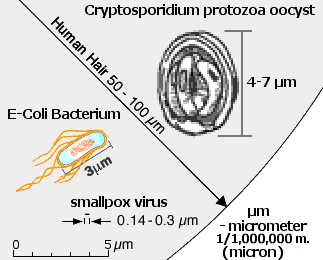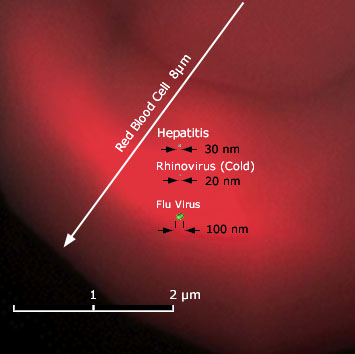 Health
Health
 Germs - Pathogens
Germs - Pathogens
Virus
Structure: Viruses are basically raw genetic material, DNA or RNA with a protein coating (called a capsid). Viruses first attach themselves to healthy cells and then inject their genetic material into those cells. The viral genetic material takes over the cells' operation, forcing the repeated production of viral proteins and genetic material. Eventually, the accumulating viral particles cause the host cell to rupture. This burst sends out large numbers of viruses to repeat the cycle of infection. Viruses are not considered to be living organisms because they cannot reproduce outside of a living cell.Types: parainfluenza, influenza, respiratory syncytial virus, HIV, rotavirus, ebola, hantavirus, variola
Reproduction: have to invade other cells and hijack their cellular machinery to reproduce.
Size: .01 - .3 µm
Diseases:
mumps, measles, Common Cold, influenza (flu), rabies, hepatitis, poliomyelitis, smallpox, AIDS, polio, Ebola, viral pneumonia,
Chickenpox, Dengue Fever, Ebola, Hepatitis (A, B, or C), Lassa Fever,
Marburg, Meningitis, Poliomyelitis, Rubella (German Measles), Yellow Fever
and certain types of cancer.
The influenza virus is a class of viruses containing RNA as its hereditary material. It replicates by entering a host cell and using this cell's resources to produce hundreds of copies of the viral RNA.
See virus page for more.
Bacteria
Structure: Single-celled organisms without a nucleus and generally ony one chrosome. Many good bacteria live in our bodies, mostly in our digestive tract. Only 300 out of some 4,600 listed species are consideered pathogens (disease causing).Types: E. coli, salmonella, Bacillus, staphylococci, enterococci, Campylobacter, shigella and Vibrio parahaemolyticus, Cholera,
Reproduction: Bacteria have ribosomes, tools necessary for copying DNA so bacteria can reproduce.
Size: .2 - 20 µm
Diseases: Cholera, diphtheria, leprosy, plague, some kinds of pneumonia, strep throat, tetanus, tuberculosis, anthrax, tooth decay, several sexually transmitted diseases, typhoid fever, Legionnaires' Disease, Lyme Disease, Meningitis, Pertussis (Whooping Cough), Strep Infections (Scarlet Fever, Rheumatic Fever, Invasive Strep), Tuberculosis, Typhus.
Parasites - Protozoans (protists)
Structure: Single-celled organisms, that may have more than one nucleus. There are 10,000 kinds of parasites, but only a few cause disease in humansTypes: Amoeba, Giardia, Coccidia, Plasmodium falciparum, Trypanosoma
Reproduction: Division
Size: 15-200 µm
Diseases: Malaria, Trypanosomiasis (African sleeping sickness), Amoebic Dysentery, Chagas' disease, giardiasis, leishmaniasis, and toxoplasmosis.
Fungi
Structure: Fungi and are generally multicellular, such as molds or mushrooms, but include single-celled yeasts. A single teaspoon of topsoil contains about 120,000 fungi.Types: gonorrhoeae, Candida, Phytophthora infestans (Irish potato famine), yeast
Reproduction: Division, budding and germination from reproductive cells called spores
Size: 1-100 * µm
Diseases: ringworm, athlete's foot, candidiasis (Thrush) and some kinds of pneumonia, and jock itch
parasitic worms
Structure: multi-celled animals.Types: Helminths. - flatworms or Platyhelminthes (flukes and tapeworms) and the roundworms or Nematoda.
Reproduction: eggs. Worms do not generally reproduce in the body.
Size: 50-100µm (eggs)
Diseases: Anisakiasis, Elephantiasis, Guinea Worm, Hookworm, River Blindness, Schistosomiasis, Tapeworm, Trichinosis
* Many fungi cells generally cling together so they are large enough to be seen.
Other Pathogenic Agents
Natural Toxins: Shellfish, Mushroom, Other
Some scientists now believe brain illnesses like mad cow disears are among a few diseases caused by an infectious agents called prions. Prions are not even DNA or RNA, but simply proteins.
Size
A micron (µm) is 1/1000 of a millimeter, a nanometer is 1/1000 of a micron.
Diameter of human hair is 50-100 microns.
- small polio virus is 28 nanometers
- chickenpox virus is .12 to .2 micron
- smallpox virus (Poxvirus variola) at .14 to .3 micron
- ebola is .8 to 1 micron
- Coronavirus - Cold
- Adenovirus - cold
- whooping cough bacteria (Bordetella pertussis) is .2 to .3 micron
- pneumonia bacteria (Mycoplasma pneumoniae) is .2 to .3 micron
- bronchitis bacteria (Chlamydia pneumoniae) is .2 to .4 micron
- meningitis bacteria (Haemophilus influenzae) is .2 to .3 micron
- tuberculosis bacteria (Mycobacterium tuberculosis) is .2 to .6 micron
- diphtheria bacteria (Corynebacteria diphtheria) is .3 to .8 micron
- scarlet fever bacteria (Streptococcus pyogenes) is .6 to 1.0 micron
- otitis media bacteria (Streptococcus pneumoniae) is .8 to 1.0 micron
- anthrax bacteria (Bacillus anthracis) is 1.0 to 1.25 microns


Treatment
The increasing use of antimicrobials in humans, animals, and agriculture has resulted in many pathogens developing resistance to these powerful drugs. All major groups of pathogens viruses, fungi, parasites, and bacteria can become resistant to antimicrobials.
Viruses are generally treated with vaccines. A vaccine is a suspension of whole or parts of bacteria or viruses (live or inactivated) that have been engineered so that they don't make the immunized person sick but do induce an immune response and prevent disease.
Examples are the polio and flu vaccines.
Some viruses (e.g. HIV) use "protease" (an enzyme that breaks down protein) to get into the cell. Drugs called protease inhibitors can be used to fight them.
Antibiotics are used for Bacterial Infections. Some
antibiotics work by interfering with the bacteria's ability to build a cell wall (e.g. Penicillin).
Antibiotics may also destroy the bacteria's ability to use nutrients or make
proteins (e.g. erythromycin, azithromycin and clarithromycin). Still others stop the bacteria from making DNA (e.g. sulfas ( "sulfanilamides" or "sulfonamides"))
See:
Traveler's diarrhea
microbe.org
Division of Microbiology and Infectious Diseases - DMID at the National Institute of Allergy and Infectious Diseases (NIAID) in the National Institutes of Health (NIH)
Bad Bug Book at the
Center for Food Safety & Applied Nutrition at the FDA
Centers for Disease Control and Prevention
Midiscan
Orthomyxoviridae Influenza Viruses.
John and Amy's Influenza Page
Bacteria vs Viruses at DRGreen.com